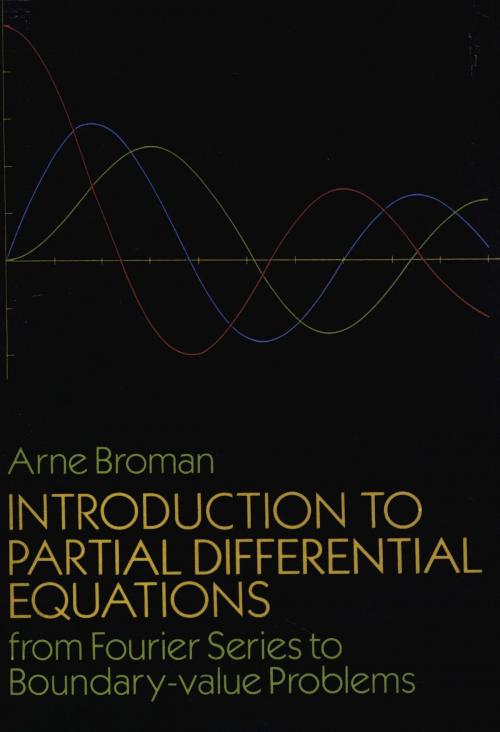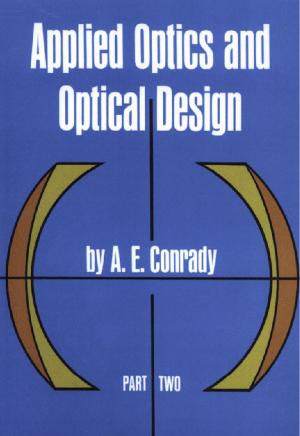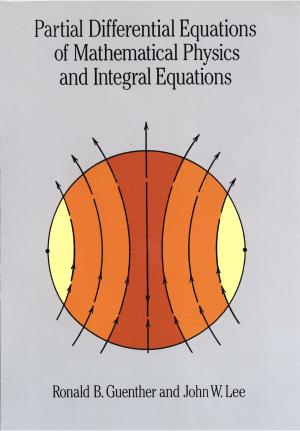Introduction to Partial Differential Equations
From Fourier Series to Boundary-Value Problems
Nonfiction, Science & Nature, Mathematics, Differential Equations| Author: | Arne Broman | ISBN: | 9780486153018 |
| Publisher: | Dover Publications | Publication: | April 27, 2012 |
| Imprint: | Dover Publications | Language: | English |
| Author: | Arne Broman |
| ISBN: | 9780486153018 |
| Publisher: | Dover Publications |
| Publication: | April 27, 2012 |
| Imprint: | Dover Publications |
| Language: | English |
This exceptionally well-written and well-organized text is the outgrowth of a course given every year for 45 years at the Chalmers University of Technology, Goteborg, Sweden. The object of the course was to give students a basic knowledge of Fourier analysis and certain of its applications. The text is self-contained with respect to such analysis; however, in areas where the author relies on results from branches of mathematics outside the scope of this book, references to widely used books are given.
Table of Contents:
Chapter 1. Fourier series
1.1 Basic concepts
1.2 Fourier series and Fourier coefficients
1.3 A minimizing property of the Fourier coefficients. The Riemann-Lebesgue theorem
1.4 Convergence of Fourier series
1.5 The Parseval formula
1.6 Determination of the sum of certain trigonometric series
Chapter 2. Orthogonal systems
2.1 Integration of complex-valued functions of a real variable
2.2 Orthogonal systems
2.3 Complete orthogonal systems
2.4 Integration of Fourier series
2.5 The Gram-Schmidt orthogonalization process
2.6 Sturm-Liouville problems
Chapter 3. Orthogonal polynomials
3.1 The Legendre polynomials
3.2 Legendre series
3.3 The Legendre differential equation. The generating function of the Legendre polynomials
3.4 The Tchebycheff polynomials
3.5 Tchebycheff series
3.6 The Hermite polynomials. The Laguerre polynomials
Chapter 4. Fourier transforms
4.1 Infinite interval of integration
4.2 The Fourier integral formula: a heuristic introduction
4.3 Auxiliary theorems
4.4 Proof of the Fourier integral formula. Fourier transforms
4.5 The convention theorem. The Parseval formula
Chapter 5. Laplace transforms
5.1 Definition of the Laplace transform. Domain. Analyticity
5.2 Inversion formula
5.3 Further properties of Laplace transforms. The convolution theorem
5.4 Applications to ordinary differential equations
Chapter 6. Bessel functions
6.1 The gamma function
6.2 The Bessel differential equation. Bessel functions
6.3 Some particular Bessel functions
6.4 Recursion formulas for the Bessel functions
6.5 Estimation of Bessel functions for large values of x. The zeros of the Bessel functions
6.6 Bessel series
6.7 The generating function of the Bessel functions of integral order
6.8 Neumann functions
Chapter 7. Partial differential equations of first order
7.1 Introduction
7.2 The differential equation of a family of surfaces
7.3 Homogeneous differential equations
7.4 Linear and quasilinear differential equations
Chapter 8. Partial differential equations of second order
8.1 Problems in physics leading to partial differential equations
8.2 Definitions
8.3 The wave equation
8.4 The heat equation
8.5 The Laplace equation
Answers to exercises; Bibliography; Conventions; Symbols; Index
Written on an advanced level, the book is aimed at advanced undergraduates and graduate students with a background in calculus, linear algebra, ordinary differential equations, and complex analysis. Over 260 carefully chosen exercises, with answers, encompass both routing and more challenging problems to help students test their grasp of the material.
This exceptionally well-written and well-organized text is the outgrowth of a course given every year for 45 years at the Chalmers University of Technology, Goteborg, Sweden. The object of the course was to give students a basic knowledge of Fourier analysis and certain of its applications. The text is self-contained with respect to such analysis; however, in areas where the author relies on results from branches of mathematics outside the scope of this book, references to widely used books are given.
Table of Contents:
Chapter 1. Fourier series
1.1 Basic concepts
1.2 Fourier series and Fourier coefficients
1.3 A minimizing property of the Fourier coefficients. The Riemann-Lebesgue theorem
1.4 Convergence of Fourier series
1.5 The Parseval formula
1.6 Determination of the sum of certain trigonometric series
Chapter 2. Orthogonal systems
2.1 Integration of complex-valued functions of a real variable
2.2 Orthogonal systems
2.3 Complete orthogonal systems
2.4 Integration of Fourier series
2.5 The Gram-Schmidt orthogonalization process
2.6 Sturm-Liouville problems
Chapter 3. Orthogonal polynomials
3.1 The Legendre polynomials
3.2 Legendre series
3.3 The Legendre differential equation. The generating function of the Legendre polynomials
3.4 The Tchebycheff polynomials
3.5 Tchebycheff series
3.6 The Hermite polynomials. The Laguerre polynomials
Chapter 4. Fourier transforms
4.1 Infinite interval of integration
4.2 The Fourier integral formula: a heuristic introduction
4.3 Auxiliary theorems
4.4 Proof of the Fourier integral formula. Fourier transforms
4.5 The convention theorem. The Parseval formula
Chapter 5. Laplace transforms
5.1 Definition of the Laplace transform. Domain. Analyticity
5.2 Inversion formula
5.3 Further properties of Laplace transforms. The convolution theorem
5.4 Applications to ordinary differential equations
Chapter 6. Bessel functions
6.1 The gamma function
6.2 The Bessel differential equation. Bessel functions
6.3 Some particular Bessel functions
6.4 Recursion formulas for the Bessel functions
6.5 Estimation of Bessel functions for large values of x. The zeros of the Bessel functions
6.6 Bessel series
6.7 The generating function of the Bessel functions of integral order
6.8 Neumann functions
Chapter 7. Partial differential equations of first order
7.1 Introduction
7.2 The differential equation of a family of surfaces
7.3 Homogeneous differential equations
7.4 Linear and quasilinear differential equations
Chapter 8. Partial differential equations of second order
8.1 Problems in physics leading to partial differential equations
8.2 Definitions
8.3 The wave equation
8.4 The heat equation
8.5 The Laplace equation
Answers to exercises; Bibliography; Conventions; Symbols; Index
Written on an advanced level, the book is aimed at advanced undergraduates and graduate students with a background in calculus, linear algebra, ordinary differential equations, and complex analysis. Over 260 carefully chosen exercises, with answers, encompass both routing and more challenging problems to help students test their grasp of the material.















